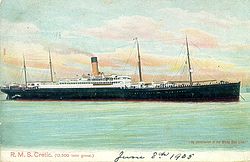Cretic
|
||||||||||||||||||||||||
|
||||||||||||||||||||||||
|
||||||||||||||||||||||||
|
||||||||||||||||||||||||
|
||||||||||||||||||||||||
The Cretic was a passenger ship put into service in 1902 , which from 1903 belonged to the British shipping company White Star Line , which used it as an ocean liner on various North Atlantic routes between Europe and North America . In 1929 the ship was scrapped after 27 years of service in Scotland .
history
The 13,507 GRT steamship was built at the Hawthorn, Leslie & Company shipyard in Hebburn, England, for the British shipping company Leyland Line based in Liverpool . The 177.39 meter long and 18.38 meter wide ship was built as an ocean liner on North Atlantic shipping routes and was supposed to carry 260 first class passengers. The ship was launched on February 25, 1902 and was christened Hanoverian . It had a chimney, four masts , two propellers, and three decks . It was equipped with electric lights , cooling devices for transporting perishable food, and a raised floor . The coal was shoveled into three single-ended and three double-ended boilers with a total of 27 fireplaces.
On July 19, 1902, the Hanoverian ran from Liverpool on her maiden voyage to Boston . The third and final crossing for the Leyland Line on this route began on September 27, 1902. In 1903, the ship was sold to the Dominion Line , which renamed it Mayflower and passenger capacity for 260 passengers in the first, 250 in the second and 1000 in the third class introduced. On April 9, 1903, the Mayflower ran out of Liverpool for her first Atlantic crossing to Boston for the new owners. She cast off for the seventh and last trip on the route on October 22, 1903.
Then the steamer was sold to the White Star Line and renamed Cretic . On November 9, 1903, the Cretic made the first of ten crossings in the service of the White Star Line from Liverpool to Boston. In November 1904 the first trip from Boston to Naples and Genoa back to Boston and New York took place. On November 21, 1911, the ship left Genoa for the last time on this route. In March 1912 the Cretic drove for the first time from Genoa via Naples directly to Boston (without a stopover in New York). On January 30, 1918, she came to Boston for the last time from Italy. From 1917 to 1919 the Cretic was subject to the Liner Requisition Theme. On September 5, 1919, the Cretic ran from Liverpool to New York and on September 24, 1919, with a capacity of 300 passengers of the first, 210 of the second and 800 of the third class, it was back on the New York – Naples route. On October 18, 1922, she made a crossing on this route for the last time.
In 1923 the Cretic was sold back to its original owner, the Leyland Line, and was renamed Devonian . The volume was reduced to 12,153 GRT through renovations. After the takeover, the ship only carried 250 passengers in the cabin class. On June 24, 1923, the Devonian first reached the port of Boston under new ownership. In April 1926 the cabin class became the tourist class. On December 10, 1927, the Devonian set off on a trip from New York via Plymouth to Antwerp . The Red Star Line had chartered her for this crossing.
On March 9, 1928, the last voyage of the ocean liner from Antwerp via Southampton to New York ended. On March 23, 1928, the Devonian steamed from New York to Philadelphia and on September 15, 1928, she left Boston for the last voyage to Liverpool. In 1929 the ship was finally scrapped at P & W McLellan in Bo'ness (Scotland).
